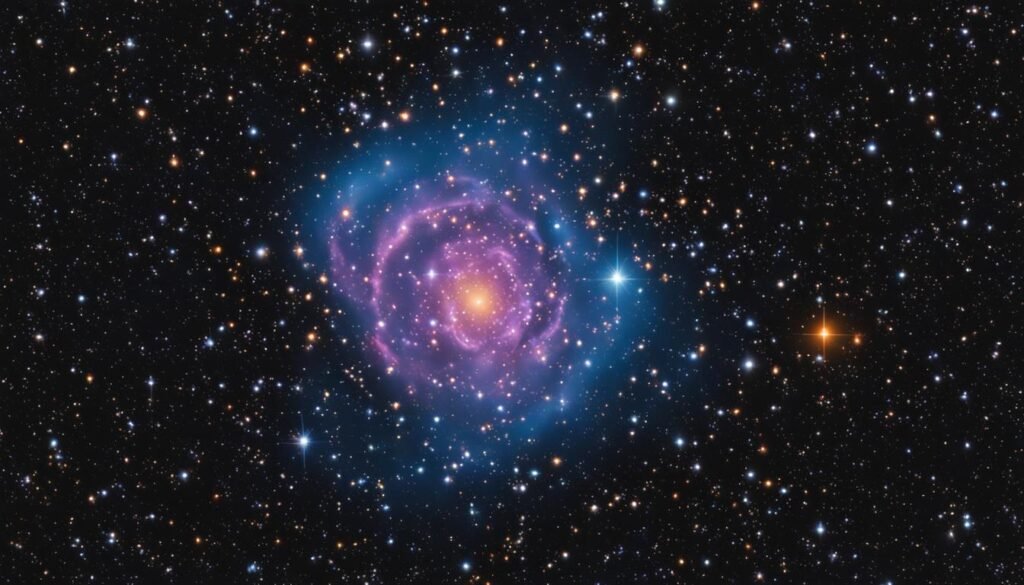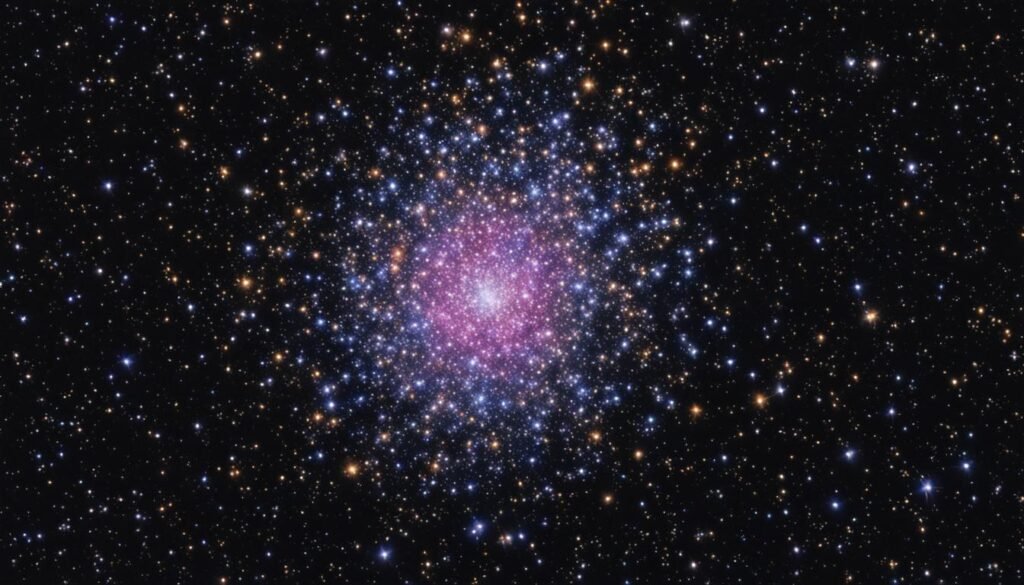Welcome to the captivating world of astronomy, where the wonders of the universe never cease to amaze. In the vast expanse above, there are countless celestial objects that have fascinated astronomers for centuries. One such object is Messier 50, also known as the Heart-Shaped Cluster. This bright open cluster is a sight to behold and is nestled within the constellation Monoceros.
Key Takeaways:
- Messier 50, also known as the Heart-Shaped Cluster, is an open cluster in the constellation Monoceros.
- It is approximately 3,200 light years away from Earth.
- Messier 50 gets its name from its distinctive heart-shaped appearance.
- The cluster is composed of young, hot, luminous blue stars, as well as yellow and orange stars.
- Messier 50 provides valuable insights into stellar formation and evolution.
Location and Observation of Messier 50
Messier 50 can be found in the constellation Monoceros, east of Orion and near the border between Monoceros and Canis Major. It is relatively easy to locate as it is located 9.5 degrees north-northeast of Sirius, the brightest star in the sky. The cluster can be observed about 20 degrees along the line formed by the three bright stars of Orion’s Belt. It is best observed during the months of December, January, and February.
Messier 50’s location in the night sky makes it accessible to both amateur and professional astronomers. Its proximity to prominent celestial landmarks, such as Orion and Sirius, provides visual reference points for finding the cluster. By following the line formed by the stars of Orion’s Belt, observers can easily locate Messier 50 as a captivating object in the constellation Monoceros.
To observe Messier 50, it is recommended to find a dark and clear sky, away from light pollution. Binoculars or a small telescope can enhance the viewing experience by revealing the individual stars within the cluster. With larger telescopes, the cluster’s rich variety of colors and magnitudes become more discernible.
Characteristics of Messier 50
Messier 50, also known as the Heart-Shaped Cluster, possesses several notable characteristics that make it a fascinating astronomical object. Let’s explore the key features of this open cluster.
Size and Structure
The angular diameter of Messier 50 measures approximately 15 by 20 arc minutes, translating to a spatial diameter of around 20 light years. The cluster presents a dense core spanning 10 arc minutes or 10 light years. This compact arrangement contributes to its distinct shape resembling a heart.
Age and Composition
Messier 50 is relatively young, estimated to be around 78 million years old. Within its stellar population, the cluster showcases an abundance of young, hot, luminous blue stars that contribute to its overall brightness. Additionally, Messier 50 consists of yellow and orange stars, adding to its diverse composition. Notably, a red M-class giant resides south of the cluster’s center, providing further celestial variety.
Scientific Significance
The characteristics of Messier 50 make it an ideal object for scientific study. As an open cluster, it enables astronomers to explore stellar formation and evolution. With its uniform age and composition, Messier 50 serves as a valuable laboratory to investigate how mass influences the life cycle of stars. Studying this cluster aids in expanding our understanding of the universe’s ongoing processes.
Summary
Messier 50 exhibits an intriguing combination of size, structure, age, and composition, making it an appealing target for astronomers. Its compact core, distinct shape, and diverse stellar population contribute to its scientific and aesthetic value. Explore the captivating beauty of Messier 50 and unravel the secrets of stellar evolution.
Historical Significance of Messier 50
Messier 50, a remarkable open cluster also known as the Heart-Shaped Cluster, holds immense historical significance in the field of astronomy. It was potentially discovered by Giovanni Domenico Cassini before 1711 and later independently observed by Charles Messier in 1772. This cluster earned its place in astronomical history as one of the objects meticulously cataloged by Messier himself. Notably, Messier 50 garnered attention from other renowned astronomers such as William Herschel and John Herschel, who provided detailed descriptions of this celestial wonder.
| Name | Contribution |
|---|---|
| Giovanni Domenico Cassini | Potential early discovery before 1711 |
| Charles Messier | Independent discovery in 1772 and cataloging |
| William Herschel | Observation and description |
| John Herschel | Observation and detailed description |
Scientific Significance of Messier 50
Messier 50, an open cluster located in the constellation Monoceros, holds great scientific significance. Its unique characteristics and composition provide valuable insights into stellar formation and evolution. By studying Messier 50, astronomers can explore how mass influences the development of stars, as all the stars within the cluster share similar ages and compositions.
This cluster’s relatively young age, estimated at 78 million years, allows scientists to examine the various stages of star formation and track their evolution over time. Additionally, Messier 50’s diverse stellar population, consisting of young, hot, luminous blue stars, as well as yellow and orange stars, presents an excellent opportunity for observational and theoretical studies.
Understanding the mechanisms behind stellar formation and evolution is crucial in expanding our knowledge of the universe and gaining a deeper understanding of our own place in it. Messier 50, with its unique characteristics and scientific importance, continues to captivate astronomers and contribute to our understanding of the cosmos.

Observation Tips for Messier 50
If you are interested in observing Messier 50, there are a few tips to enhance your viewing experience.
Firstly, know that Messier 50 can be observed with both binoculars and a small telescope. With binoculars, it may appear as a nebulous patch of light. However, when using a telescope, you will have the opportunity to resolve individual stars within the cluster.
Keep in mind that larger telescopes may reveal the cluster’s rich variety of colors and magnitudes, allowing for a more detailed observation.
To optimize your chances of seeing Messier 50, it is recommended to find a clear, dark sky during the winter months. This will minimize light pollution and provide better visibility.
Take your time to study Messier 50 and appreciate its beauty. The cluster’s heart-shaped figure and diverse array of stars make for a captivating celestial sight.

| Observation Tips for Messier 50 |
|---|
| Use binoculars or a small telescope to observe Messier 50. |
| With binoculars, Messier 50 may appear as a nebulous patch of light. |
| Telescopes can resolve individual stars within the cluster. |
| Larger telescopes may reveal the cluster’s rich variety of colors and magnitudes. |
| Find a clear, dark sky during the winter months for optimal viewing. |
Messier 50 Images
Messier 50, also known as the Heart-Shaped Cluster, has captured the attention of observatories and astrophotographers alike, resulting in stunning images that showcase its unique characteristics and celestial beauty. These images provide a visual representation of the cluster’s heart-shaped figure and the diverse array of stars within.
One of the notable features captured in these images is the cluster’s heart-shaped figure, which gives it its distinctive nickname. The arrangement of stars forms a captivating pattern that resembles the shape of a heart, adding to its allure and appeal.
Furthermore, the images reveal the rich assortment of stars present in Messier 50. From young, hot, luminous blue stars to vibrant yellow and orange stars, the cluster offers a colorful and vibrant tapestry of stellar objects. The diverse stellar population provides valuable insights into the formation and evolution of stars within the cluster.
These mesmerizing images of Messier 50 serve as a visual testament to its captivating characteristics and intricate beauty. They inspire and fascinate astronomy enthusiasts, allowing them to marvel at the wonders of the universe and the celestial treasures it holds.
Observing Difficulty of Messier 50
Messier 50 is a captivating object to observe in the night sky, with its distinctive shape and diverse stellar population. Luckily, it is considered an easy target for observation, making it accessible to both beginner and experienced astronomers.
With a relatively bright visual magnitude of 5.9, Messier 50 can even be seen with the naked eye under ideal dark sky conditions. However, to truly appreciate its beauty and uncover more details, using binoculars or a small telescope is recommended.
When observed through binoculars, Messier 50 appears as a nebulous patch of light. The cluster’s individual stars become more visible and resolved when observed through a small telescope. Larger telescopes can reveal even more of the cluster’s rich variety of colors and magnitudes.
Fortunately, Messier 50 is conveniently located within the constellation Monoceros, making it readily accessible for observation. To increase your chances of a successful observation, it is best to find a clear, dark sky during the winter months when the cluster is most visible.
So, whether you’re a beginner or an experienced stargazer, don’t miss the opportunity to witness the captivating beauty of Messier 50. Grab your binoculars or telescope, find a suitable observing spot, and prepare to be amazed by the wonders of the Heart-Shaped Cluster.
“Messier 50 is an accessible and visually stunning cluster that rewards observers with its unique shape and diverse population of stars. Whether you’re using binoculars or a telescope, taking the time to observe this celestial treasure is certainly worthwhile!”
Conclusion
Messier 50, also known as the Heart-Shaped Cluster, is a captivating open cluster located in the constellation Monoceros. This beautiful celestial treasure offers both scientific and observational opportunities for astronomy enthusiasts.
With its distinctive heart-shaped figure and diverse population of stars, Messier 50 provides a mesmerizing sight in the night sky. Its location in the constellation Monoceros makes it easily accessible for observation, adding to its appeal.
As a relatively young cluster, Messier 50 allows astronomers to study stellar formation and evolution. Its composition of young, hot, luminous blue stars, as well as yellow and orange stars, unveils valuable insights into the impact of mass on star development.
Whether you are an aspiring astronomer or simply a lover of the night sky, Messier 50 is an object of fascination. Its sheer beauty and scientific significance make it a must-see celestial marvel that will undoubtedly spark your imagination and leave you in awe of the vastness and wonders of our universe.
FAQ
What is Messier 50?
Messier 50, also known as the Heart-Shaped Cluster, is a bright open cluster located in the constellation Monoceros. It is named for its distinctive shape that resembles a heart.
Where is Messier 50 located and how can I observe it?
Messier 50 can be found in the constellation Monoceros, east of Orion and near the border between Monoceros and Canis Major. It is best observed during the months of December, January, and February. To locate it, you can look 9.5 degrees north-northeast of Sirius, the brightest star in the sky, and about 20 degrees along the line formed by the three bright stars of Orion’s Belt. It is visible with binoculars or a small telescope.
What are the characteristics of Messier 50?
Messier 50 has an apparent magnitude of 5.9 and is approximately 3,200 light years away from Earth. It has an angular diameter of about 15 by 20 arc minutes, and its dense core spans 10 arc minutes or 10 light years. The cluster contains many young, hot, luminous blue stars, as well as yellow and orange stars. It also includes a red M-class giant located south of the cluster’s center.
What is the historical significance of Messier 50?
Messier 50 was possibly discovered by Giovanni Domenico Cassini before 1711 and was later independently discovered by Charles Messier in 1772. It holds a significant place in astronomical history as one of the objects cataloged by Messier. The cluster was also observed by William Herschel and John Herschel, who provided detailed descriptions.
What is the scientific significance of Messier 50?
Messier 50 is of scientific interest as an open cluster that allows astronomers to study stellar formation and evolution. It provides insights into how mass affects the evolution of stars, as all the stars in the cluster are roughly the same age and composition. The cluster’s relatively young age and diverse stellar population make it an ideal target for observational and theoretical studies.
How can I observe Messier 50?
Messier 50 can be observed with binoculars or a small telescope. With binoculars, it appears as a nebulous patch of light, while telescopes can resolve individual stars within the cluster. Larger telescopes may reveal the cluster’s rich variety of colors and magnitudes. It is best observed during the winter months in a clear, dark sky.
Are there any images of Messier 50 available?
Yes, Messier 50 has been photographed and imaged by various observatories and astrophotographers. These images showcase the cluster’s heart-shaped figure and the diverse array of stars within. They provide a visual representation of the cluster’s characteristics and beauty.
Is Messier 50 difficult to observe?
Messier 50 is considered an easy object to observe as it has a relatively bright visual magnitude of 5.9. It can be seen with the naked eye under ideal dark sky conditions, but binoculars or a small telescope will reveal more detail and resolve individual stars. Its position within the constellation Monoceros makes it readily accessible for observation.






